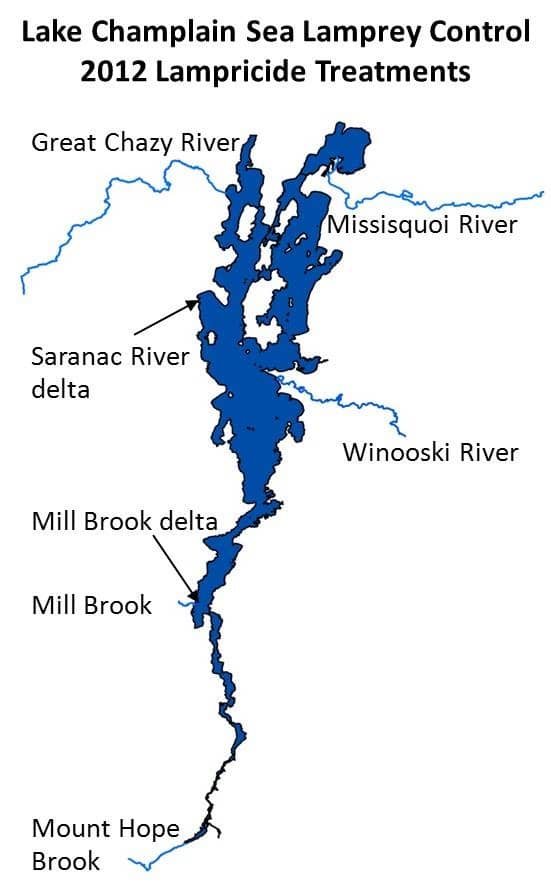Lake Champlain Fish and Wildlife Management Cooperative Will Treat Five Rivers and Two Deltas to Control Sea Lamprey Populations
OutdoorHub 08.23.12

The Lake Champlain Fish and Wildlife Management Cooperative (Cooperative) will be applying lampricides to portions of five tributaries to Lake Champlain and two deltas during the months of September and October.
The U.S. Fish and Wildlife Service, Vermont Department of Fish and Wildlife, and New York State Department of Environmental Conservation will be treating the Saranac River delta, Mill Brook delta, Mill Brook, Great Chazy River, and Mount Hope Brook in New York and the Winooski and Missisquoi rivers in Vermont as part of the Cooperative’s long-term sea lamprey control program for Lake Champlain. Treatments are scheduled to begin with the Saranac River delta on September 10th, but weather conditions may affect planned treatment dates. While trout and salmon populations of the lake are the primary beneficiaries of these efforts, lake sturgeon, walleye, and many other species also benefit from sea lamprey control. Sea lamprey control also generates economic activity by increasing angling opportunities and the time that boaters, anglers, and their families spend in the Lake Champlain area.
Annual sea lamprey assessments continue to show the success of the program where we recorded an average of 30 sea lamprey wounds per 100 lake trout and 19 per 100 Atlantic salmon in 2011. This is down from a high of 99 for lake trout in 2007 and 79 for Atlantic salmon in 2003. Several control initiatives are underway that will further reduce the sea lamprey population and reduce their impacts on Lake Champlain’s fish populations.
Larval sea lamprey live in rivers and on deltas for about four years before transforming to their parasitic phase and emigrating to Lake Champlain where their effect on the fishery becomes apparent. One of the Cooperative’s Integrated Pest Management approaches is to apply selective pesticides (lampricides) to rivers and deltas in prescribed and precise concentrations. The concentrations used are carefully chosen and monitored to ensure effective elimination of sea lamprey larvae and protection of non-target species. TFM (3-trifluoromethyl-4-nitrophenol) will be applied in the rivers for 12-14 hours depending on conditions.
A second lampricide, Bayluscide 20% Emulsifiable Concentrate, is being included in the application on the Winooski River. The use of 1% Bayluscide with TFM reduces the amount of TFM needed by about 40%, resulting in a reduction of total lampricide applied and substantial cost savings. The Saranac River and Mill Brook deltas will be treated with Granular Bayluscide: lampricide-coated sand grains that release pesticide after sinking to the bottom where they effectively kill sea lamprey larvae.
Our toll-free number (1-888-596-0611) provides information on the treatment schedule for each of the treatments, progress reports, updates on treatments, and water use advisories.
Temporary water use advisories will be in effect for each of the treatments to minimize human exposure to affected waters. Each state’s Department of Health recommends that the treated river and lake water not be used for drinking, swimming, fishing, irrigation, or livestock watering while the advisories are in effect.
 The treatments and water use advisories will have no effect on most residents in the Champlain Basin and no municipal water supply systems will be affected. Cooperative staff have identified all landowners with property in the affected areas. A letter was sent to residents informing them of the planned treatment and asking them if they or their livestock use water from a surface supply that will be affected by the treatment. Days before the treatments begin, another letter will be sent to inform residents of the impending treatment and to arrange any water usage accommodations.
The treatments and water use advisories will have no effect on most residents in the Champlain Basin and no municipal water supply systems will be affected. Cooperative staff have identified all landowners with property in the affected areas. A letter was sent to residents informing them of the planned treatment and asking them if they or their livestock use water from a surface supply that will be affected by the treatment. Days before the treatments begin, another letter will be sent to inform residents of the impending treatment and to arrange any water usage accommodations.
Local television and radio stations will broadcast the dates when advisories begin and expire. The treatment schedule is subject to change as weather conditions, stream flows, or logistical issues may arise during the treatments. Residents will be kept apprised of any such changes through these media.

